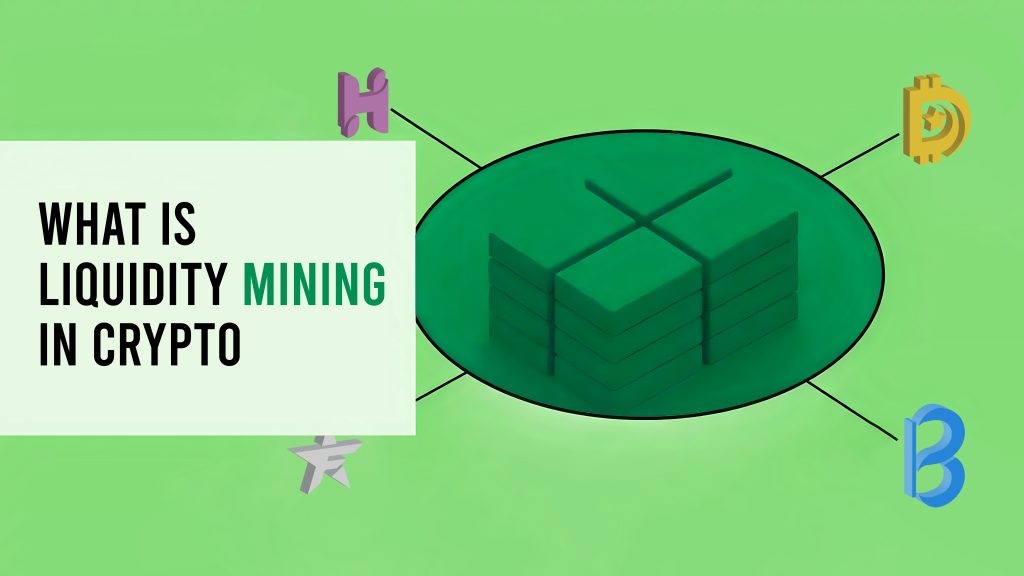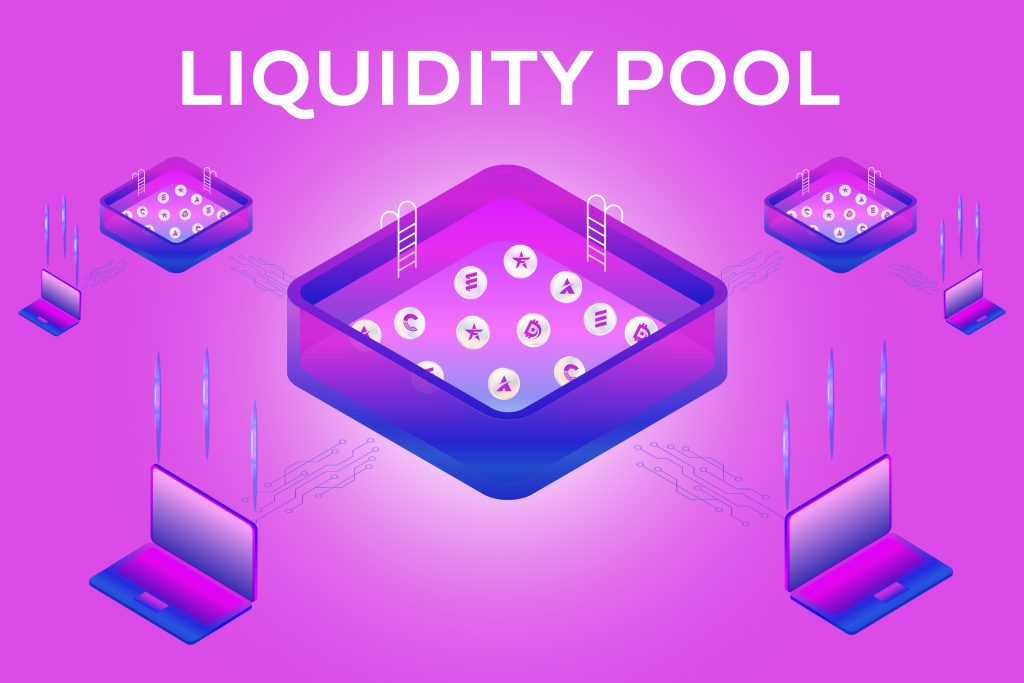Liquidity Mining: What is It and How to Get Started
Liquidity mining is the new star in the DeFi universe, quickly becoming a go-to for savvy crypto investors. Yet, this strategy is not just about earning potential; it is about actively contributing to the DeFi ecosystem. In this article, we will explore the world of liquidity mining — from how it works to the rewards and risks involved. Whether you are just starting out or are a seasoned crypto enthusiast – we have got you covered! Let us get started!

What Does Liquidity Mining Mean?
Liquidity mining is a process in the DeFi ecosystem where users provide liquidity to a decentralized exchange (DEX) by depositing their cryptocurrency assets into a liquidity pool. In return for their contribution, these liquidity providers earn rewards, usually in the form of transaction fees or native tokens of the platform.
The concept of liquidity mining revolves around the idea of decentralized and community-driven financial services, where the users themselves facilitate trading and lending services, rather than relying on traditional financial intermediaries.
Liquidity mining is often seen as a win-win for both the liquidity providers and the DeFi platform. Providers earn rewards for their contributions, while the platform benefits from increased liquidity, which leads to better service efficiency and a more robust trading environment.
How Does Liquidity Mining Work?
The process of liquidity mining involves several key steps:
- Depositing Assets: Users deposit their crypto assets into a liquidity pool, which is a smart contract that holds funds and enables trading on the platform.
- Providing Liquidity: By depositing assets, users are providing liquidity, making it easier for others to trade or borrow these assets.
- Earning Rewards: In exchange for providing liquidity, users earn rewards. These rewards can come in various forms, such as a share of the trading fees or newly issued tokens from the platform.
- Yield Farming: Liquidity mining is often associated with yield farming, where users move their assets between different pools to maximize their rewards.
- Risks and Considerations: While lucrative, liquidity mining also involves risks such as impermanent loss, where the value of deposited assets changes compared to when they were deposited.

The Benefits of Liquidity Mining
Liquidity mining offers several attractive benefits within the DeFi ecosystem, making it a popular choice among crypto enthusiasts. These include:
- Attractive Returns: Often, liquidity mining provides higher potential returns compared to traditional investment methods. This is due to the combination of transaction fee shares and rewards in the form of tokens.
- Contribution to DeFi Ecosystem: By providing liquidity, participants play a crucial role in the DeFi ecosystem, supporting the efficiency and stability of decentralized exchanges.
- Token Distribution: Liquidity mining is a way for DeFi platforms to distribute their native tokens to a wide user base, aligning the interests of users with the platform.
- Access to New Tokens: Participants in liquidity mining often receive new tokens as rewards, potentially before they are available on the open market, offering early access to promising projects.
- Diversification: For investors looking to diversify their portfolio, liquidity mining offers exposure to a variety of DeFi projects and cryptocurrencies.
What Risks are Associated with Liquidity Mining?
While liquidity mining can be lucrative, it is important to be aware of the following risks:
- Impermanent Loss: This occurs when the price of your deposited assets changes compared to when they were deposited. It is a common risk in liquidity mining, especially in volatile markets.
- Smart Contract Risks: Liquidity mining relies on smart contracts. Flaws or vulnerabilities in these contracts can lead to the loss of staked assets.
- Market Volatility: The crypto market is notorious for its fluctuating nature. Sudden shifts in prices can significantly impact both the value of your staking rewards and the underlying assets themselves.
- Regulatory Uncertainty: The DeFi space is subject to evolving regulatory landscapes, which can impact the viability and legality of certain liquidity mining practices.
- Exit Scams and Rug Pulls: There have been instances where DeFi projects turned out to be scams, with developers disappearing with users’ funds.

What is the Difference Between Liquidity Mining and Staking?
Although liquidity mining and staking are both popular DeFi strategies, they have distinct differences:
- Function in the Network: Staking involves holding and locking up cryptocurrencies to support the operations of a blockchain network, primarily in networks using a Proof of Stake (PoS) consensus mechanism. Liquidity mining, on the other hand, is about providing liquidity to DeFi platforms, especially decentralized exchanges.
- Reward Mechanisms: In staking, rewards are typically earned as a part of the blockchain’s consensus mechanism. In liquidity mining, rewards come from transaction fees generated in the liquidity pool or as additional tokens from the DeFi platform.
- Risk Profile: Liquidity mining often involves a higher risk, especially due to impermanent loss, compared to staking. Staking risks are generally associated with the volatility of the staked asset and the network’s stability.
What’s the Difference Between Liquidity Mining and Yield Farming?
Liquidity mining and yield farming are closely related, but they are not the same:
- Scope: Liquidity mining is a subset of yield farming. While all liquidity mining can be considered yield farming, not all yield farming is liquidity mining.
- Strategy Complexity: Yield farming often involves a combination of different strategies, including liquidity mining, staking, and sometimes leveraging these positions. Liquidity mining is generally more straightforward, focusing solely on providing liquidity to earn rewards.
- Rewards: Yield farming strategies may involve moving assets across different platforms and pools to optimize earnings, while liquidity mining is typically about earning rewards from a single liquidity pool.
How Do You Get Started?
To begin liquidity mining, follow these steps:
- Research: Understand the basics of DeFi and identify reputable platforms that offer liquidity mining.
- Choose a Platform: Select a DeFi platform that aligns with your investment goals and risk tolerance.
- Select a Pool: Choose a liquidity pool that suits your asset holdings and reward expectations.
- Provide Liquidity: Deposit your assets into the pool, but make sure you understand the process and any associated fees before proceeding.
- Monitor and Manage: Keep an eye on your investment and be prepared to adjust your strategy in response to market changes.
Final Thoughts: Is It Worth It?
In the end, liquidity mining can be a lucrative venture in the DeFi space, but it is not without its challenges. In other words, the potential for high returns must be weighed against the risks of impermanent loss, market volatility, and smart contract vulnerabilities.
For those who are well-informed and comfortable with the risks, liquidity mining can be a rewarding addition to their crypto investment strategy. However, it is crucial to approach this with caution, thorough research, and a clear understanding of the rapidly evolving DeFi landscape.
So, the key takeaway here is that if you venture into liquidity mining with thorough research and a clear strategy, it can be a powerful way to enhance your portfolio and deepen your understanding of the DeFi world.
